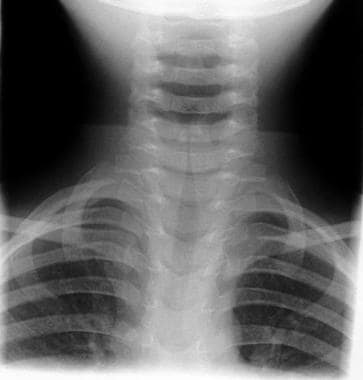Practice Essentials
Croup is a common, primarily pediatric viral respiratory tract illness. As its alternative names, acute laryngotracheitis and acute laryngotracheobronchitis, indicate, croup generally affects the larynx and trachea, although this illness may also extend to the bronchi. This respiratory illness, recognized by physicians for centuries, derives its name from an Anglo-Saxon word, kropan, or from an old Scottish word, roup, meaning to cry out in a hoarse voice.
Signs and symptoms
Croup is the most common etiology for hoarseness, cough, and onset of acute stridor in febrile children. Symptoms of coryza may be absent, mild, or marked. The vast majority of children with croup recover without consequences or sequelae; however, it can be life-threatening in young infants.
Croup manifests as hoarseness, a seal-like barking cough, inspiratory stridor, and a variable degree of respiratory distress. However, morbidity is secondary to narrowing of the larynx and trachea below the level of the glottis (subglottic region), causing the characteristic audible inspiratory stridor (see the image below).
 Child with croup. Note the steeple or pencil sign of the proximal trachea evident on this anteroposterior film. Courtesy of Dr. Kelly Marshall, CHOA at Scottish Rite.
Child with croup. Note the steeple or pencil sign of the proximal trachea evident on this anteroposterior film. Courtesy of Dr. Kelly Marshall, CHOA at Scottish Rite.
Stridor
Stridor is a common symptom in patients with croup. [1] Acute onset of this abnormal sound in a child alarms parents and caregivers, enough to prompt an urgent care or emergency department (ED) visit. Stridor is an audible harsh, high-pitched, musical sound on inspiration produced by turbulent airflow through a partially obstructed upper airway. This partial airway obstruction can be present at the level of the supraglottis, glottis, subglottis, and/or trachea. During inspiration, areas of the airway that are easily collapsible (eg, supraglottic region) are suctioned closed because of negative intraluminal pressure generated during inspiration. These same areas are forced open during expiration.
Depending on timing within the respiratory cycle, stridor can be heard on inspiration, expiration, or in both (biphasic; inspiratory and expiratory). Inspiratory stridor suggests a laryngeal obstruction, whereas expiratory stridor suggests tracheobronchial obstruction. Biphasic stridor indicates either a subglottic or glottic anomaly. An acute onset of marked inspiratory stridor is the hallmark of croup; however, concurrently there may be a less audible expiratory stridor.
Young infants who present with stridor require a thorough evaluation to determine the etiology and, most importantly, to exclude rare life-threatening causes. Although croup is usually a mild, self-limited disease, upper airway obstruction may cause respiratory distress and pose risk of death.
See Presentation for more detail.
Diagnosis
Croup is primarily a clinical diagnosis, with the diagnostic clues based on presenting history and physical examination findings.
See Workup for more detail.
Management
Current treatment approaches in urgent care clinics and emergency departments are corticosteroids and nebulized epinephrine; steroids have proven beneficial in severe, moderate, and even mild croup.
See Treatment and Medication for more detail.
Patient education
For patient education information, see the Lung Disease and Respiratory Health Center, as well as Croup.
Etiology
Viruses causing acute infectious croup are spread through either direct inhalation from a cough and/or sneeze, or by contamination of hands from contact with fomites with subsequent touching the mucosa of the eyes, nose, and/or mouth. The most common viral etiologies are parainfluenza viruses. The type of parainfluenza (1, 2, and 3) virus causing croup outbreaks varies each year.
The primary ports of viral entry are the nose and nasopharynx. The infection spreads and eventually involves the larynx and trachea. The lower respiratory tract may also be affected, as in acute laryngotracheobronchitis. Some practitioners feel that with lower airway involvement, further diagnostic evaluation is warranted to address concern for a secondary bacterial infection.
Inflammation and edema of the subglottic larynx and trachea, especially near the cricoid cartilage, are most clinically significant. Histologically, the involved area is edematous, with cellular infiltration located in the lamina propria, submucosa, and adventitia. The infiltrate contains lymphocytes, histiocytes, neutrophils and plasma cells. Parainfluenza virus activates chloride secretion and inhibits sodium absorption across the tracheal epithelium, contributing to airway edema. The anatomical area impacted is the narrowest part of the pediatric airway; accordingly, swelling can significantly reduce the diameter, limiting airflow. This narrowing results in the seal-like barky cough, turbulent airflow, stridor, and chest wall retractions. Endothelial damage and loss of ciliary function also occur. A mucoid or fibrinous exudate partially occludes the lumen of the trachea. Decreased mobility of the vocal cords due to edema leads to the associated hoarseness.
In severe disease, fibrinous exudates and pseudomembranes may develop, causing even greater airway obstruction. Hypoxemia may occur from progressive luminal narrowing and impaired alveolar ventilation and ventilation-perfusion mismatch.
Spasmodic croup (laryngismus stridulus) is a noninfectious variant of the disorder, with a clinical presentation similar to that of the acute disease but typically without fever and with less coryza. This type of croup always occurs at night and has the hallmark of reoccurrence in children; hence it has also been called “recurrent croup.” In spasmodic croup, subglottic edema occurs without the inflammation typical in acute viral disease. Although viral illnesses may trigger this variant, the reaction may be of allergic etiology rather than a direct result of an infectious process.
Causes
Parainfluenza viruses (types 1, 2, 3) are responsible for about 80% of croup cases, with parainfluenza types 1 and 2, accounting for nearly 66% of cases. Type 3 parainfluenza virus causes bronchiolitis and pneumonia in young infants and children. Type 4 parainfluenza virus, with subtypes 4A and 4B, is not as well understood and tends to be associated with a milder clinical illness.
The different parainfluenza types have a more prominent role in the infectious process, as related to the patient’s age. Infection with type 3 occurs most often in infants and is the etiology of lower respiratory tract illness; by age 1 year, 50% of infants have acquired this infection. Respiratory infections in children aged 1-5 years are most often due to type 1, less so with type 2. [2]
Other infectious causes for croup-like illnesses include the following:
-
Adenovirus
-
Respiratory syncytial virus (RSV)
-
Enterovirus
-
Human bocavirus
-
Coronavirus [3]
-
Rhinovirus
-
Echovirus
-
Reovirus
-
Metapneumovirus [4]
-
Rarer causes - Measles virus, herpes simplex virus, varicella
Infection with influenza A is associated with severe respiratory disease, as it has been detected in children with marked respiratory compromise. The bacterial pathogen, Mycoplasma pneumoniae, has also been identified in a few cases of croup. [5] Prior to 1970, diphtheria, also known as membranous croup, was a common cause of croup-like symptoms. Vaccine coverage for diphtheria has eliminated this infection with no case reported in the United States for decades.
Epidemiology
Croup is the most common pediatric illness that causes acute stridor, accounting for approximately 15% of annual clinic and emergency department visits for pediatric respiratory tract infections. Croup is primarily a disease of infants and toddlers.
The disease occurs most often in late fall and early winter, but may present at any time of the year. Approximately 5% of children will experience more than one episode.
Sex- and age-related demographics
The male-to-female ratio for croup is approximately 1.4:1.
Primarily a disease of infants and toddlers, croup has a peak incidence in patients from age 6 months to 3 years. In North America, incidence peaks during the second year of life, at 5-6 cases per 100 children. Although uncommon after age 6 years, croup may be diagnosed in the preteen and adolescent years and, rarely in adults. [6]
Prognosis
The prognosis for croup is excellent, and recovery is almost always complete. The majority of patients can be managed successfully as outpatients, without the need for inpatient hospital care. Hospitalization rates vary widely among communities, ranging from 1.5-30% and typically averaging 2-5%. Throughout the 1990s, US hospitalizations averaged approximately 41,000 per year but appear to have subsequently decreased. Fewer than 2% of hospitalized children require intubation. Current use of steroids and nebulized epinephrine for treatment of patients with croup may thwart the need to intubate. [7] A 10-year study found a mortality rate of less than 0.5% in intubated patients, although overall exact mortality is not known. [8]
Some evidence suggests that hospitalization for croup may be associated with future development of asthma. Children hospitalized for croup have demonstrated higher levels of bronchial hyperresponsiveness and an allergic response to skin testing. Further factors that could contribute to asthma later in life are history of recurrent croup, family history of asthma, and smoking exposure in the home environment.
Complications
Complications in croup are rare. In most series, less than 5% of children who were diagnosed with croup required hospitalization and less than 2% of those who were hospitalized were intubated. Death occurred in approximately 0.5% of intubated patients.
A secondary bacterial infection may result in pneumonia or bacterial tracheitis. Bacterial tracheitis is a life-threatening infection that can arise after the onset of an acute viral respiratory infection. [9, 10, 11, 12] In this clinical scenario, the child usually has a mild to moderate illness for 2-7 days, but then develops severe symptoms. These patients typically have a toxic appearance and do not respond well to nebulized racemic epinephrine (treatment modality for croup). Cases of suspected bacterial tracheitis require hospitalization with close observation, broad-spectrum antibiotics, and, occasionally, endotracheal intubation. Key bacterial pathogens are Staphylococcus aureus including methicillin-resistant strains (MRSA), group A streptococcus (Streptococcus pyogenes), Moraxella catarrhalis, Streptococcus pneumoniae, Haemophilus influenzae, and anaerobes.
Pulmonary edema, pneumothorax, pneumomediastinum, lymphadenitis, and otitis media have also been reported in patients diagnosed with croup. Poor ability to maintain adequate oral intake, plus increased insensible fluid losses, can lead to dehydration; as such, patients may require intravenous fluid hydration to stabilize their fluid status.
-
Child with croup. Note the steeple or pencil sign of the proximal trachea evident on this anteroposterior film. Courtesy of Dr. Kelly Marshall, CHOA at Scottish Rite.
-
Steeple sign on radiograph.







